
Genus Capra, the Goats & Ibex
Capra is a genus of mammals, the goats, composed of up to nine species, including the markhor and many species known as ibexes. The domestic goat (Capra hircus) is a domesticated species derived from the wild goat (Capra aegagrus). Evidence of goat domestication dates back more than 8,500 years.
Wild goats are animals of mountain habitats. They are very agile and hardy, able to climb on bare rock and survive on sparse vegetation. They can be distinguished from the genus Ovis, which includes sheep, by the presence of scent glands close to the feet, in the groin, and in front of the eyes, and the absence of other facial glands, and by the presence of a beard in some specimens, and of hairless calluses on the knees of the forelegs.
The Rocky Mountain goat is in a separate genus, Oreamnos. Present-day genetic and phenotypic differences between the Capra species are largely related to discontinuity of and impeded migration between Capra populations during glacial periods, and insufficient time in the postglacial period for now-adjoining Capra populations to overcome behavioral mechanisms impeding hybridization in the wild so as to erase these differences.
All members of the genus Capra are bovids (members of the family Bovidae), and more specifically caprines (subfamily Caprinae). As such they are ruminants, meaning they chew the cud, and have four-chambered stomachs which play a vital role in digesting, regurgitating, and redigesting their food.
The genus has sometimes been taken to include Ovis (sheep) and Ammotragus (Barbary sheep),[3] but these are usually regarded as distinct genera, leaving Capra for ibexes. In this smaller genus, some authors have recognized only two species, the markhor on one side and all other forms included in one species on the other side. Today, nine species are usually accepted - the species below being featured in this page:
Siberian or Mid-Asian Ibex (Capra sibirica alaiana)
Mid-Asian Ibex (Capra sibirica sakeen)
Alpine Ibex (Capra ibex)
Western Spanish or Gredos Ibex (Capra pyrenaica victoriae)
Southeastern or Sierra Nevada Ibex (Capra pyrenaica penibeticus)
Southeastern or Beceite Ibex (Capra pyrenaica hispanica)
Southeastern or Ronda Ibex (Capra pyrenaica meridionalis)
Walia Ibex (Capra walie)
Kri Kri Wild Goats (Capra hircus cretica)
The Siberian ibex (Capra sibirica), also known as the Altai ibex, Central Asia(n) ibex, Gobi ibex, Himalayan ibex, Mongolian ibex or Tian Shan ibex, is a species of ibex that lives in central Asia. It has traditionally been treated as a subspecies of the Alpine ibex, and whether it is specifically distinct from other ibex is still not entirely clear. It is the longest and heaviest member of the genus Capra, though its shoulder height is surpassed by the markhor.
Siberian ibexes are large and heavily built goats, although individual sizes vary greatly. Males are between 88 and 110 cm (35 and 43 in) in shoulder height, and weigh between 60 and 130 kg (130 and 290 lb). Females are noticeably smaller, with heights between 67 and 92 cm (26 and 36 in), and weights between 34 and 56 kg (75 and 123 lb). The nose is straight in profile, the neck short, and the back straight. The neck is also particularly thick and muscular in males, but much less so in females. Both sexes have beards, although the male's beard is more pronounced, and those of females are sometimes absent altogether. Both sexes also possess a large scent gland, about 3 cm (1.2 in) across, beneath the tail.
The coat of Siberian ibex is well suited for camouflage in mountains with low or no vegetation.
The female's horns are relatively small, and grey-brown in colour, measuring an average of 27 cm (11 in) long. Those of fully-grown males are black and typically measure about 115 cm (45 in), although in extreme cases they can grow to 148 cm (58 in). Both sexes have circular rings around their horns that represent annual growth, but males also have large transverse ridges along the front surface. The exact shape of the horns varies considerably between individuals.
The colouration is also variable, from dark brown to light tan, with some reddish individuals. There is usually a stripe of darker hair down the centre of the back and onto the tail, and some males have saddle-like patches on the back in the winter. The undersides are paler, and, in the winter, mature males becoming much darker with white patches. Females and infants are generally more bland in colour than the adult males, and do not always have the stripe down the back. Siberian ibexes typically moult between April and July, developing their paler summer coat, which continues to grow and become darker as the year progresses, reaching the full winter condition around December.
Subspecies
Though some recent authorities treat the species as monotypic, others have recognized four subspecies, based mainly on differences in total size, size of horns and colour of pelage:
C. s. sibirica (Siberian or Altai Ibex) – Sayan Mountains
C. s. alaiana (Tian Shan Ibex) – Alay Mountains
C. s. hagenbecki (Gobi or Mongolian Ibex) – western Mongolia
C. s. sakeen (Himalayan Ibex – Pamir Mountains, western Himalayas, India, Afghanistan and Pakistan
Siberian or Mid-Asian Ibex (Capra sibirica alaiana) - Tian Shan Mountains, Western China - Xinjiang





































































































































































































































































































Mid-Asian Ibex (Capra sibirica sakeen) - Hemis National Park India
























The Alpine ibex (Capra ibex), also known as the steinbock, bouquetin, or simply ibex, is a species of wild goat that lives in the mountains of the European Alps. It is a sexually dimorphic species: males are larger and carry longer, curved horns than females. Its coat colour is typically brownish grey. Alpine ibex tend to live in steep, rough terrain near the snow line. They are also social, although adult males and females segregate for most of the year, coming together only to mate. Four distinct groups exist; adult male groups, female-offspring groups, groups of young individuals, and mixed-sex groups.
During the breeding season, males fight for access to females, and use their long horns in agonistic behaviour. After being extirpated from most areas by the 19th century, the Alpine ibex was successfully reintroduced to parts of its historical range. All individuals living today descend from the stock in Gran Paradiso National Park in Aosta Valley and Piemonte (Italy), a national park created to help the ibex thrive. The ibex is the emblem of both the Gran Paradiso National Park, and the contiguous Vanoise National Park across the French border. The species is currently listed as of least concern by the IUCN, but went through a population bottleneck of fewer than 100 individuals during its near-extinction event. This has led to very low genetic diversity across populations.
During the Last Glacial Period the species range was reaching as far south as Greece, where it disappeared in the Holocene, after 5,600 BC due to hunting, with the last known remains being found on mountains surrounding Thessaly. The Alpine ibex was, at one point, restricted only to the Gran Paradiso National Park in northern Italy, and the contiguous Maurienne Valley in the French Alps but it was reintroduced to most of the Alps. Reintroductions started in 1906 into Switzerland. Alpine ibex are now found in most or all of the Italian and French alpine ranges, southern Germany, Switzerland and Austria. It has also been introduced to Bulgaria and Slovenia.
An excellent climber, its preferred habitat is the rocky region along the snow line above alpine forests, where it occupies steep, rough terrain at elevations of 1,800 to 3,300 m (5,900 to 10,800 ft). Alpine ibex are typically absent from woodland areas, although adult males in densely populated areas may stay in larch and mixed larch-spruce woodland if no snow has fallen. Males spend the winter in coniferous forests. For most of the year, males and females occupy different habitats.[9] Females rely on steep terrain more so than males. Males use lowland meadows during the spring, which is when snow melts and green grass appears.[10] They then climb to alpine meadows during the summer. When winter arrives, both sexes move to steep, rocky slopes that amass little snow. They prefer slopes of 30–45° and use small caves and overhangs for shelter. Home ranges are highly variable, depending on the availability of resources, and vary in size throughout the year. Figures from 180 to 2,800 ha (0.69 to 10.81 sq mi) have been recorded. Home ranges tend to be largest during summer and autumn, smallest in winter, and intermediate in spring. Female home ranges are usually smaller than those of males. Alpine ibex appear to have a low rate of predation and in Gran Paradiso typically die of age, starvation, or disease.
Alpine Ibex (Capra ibex) - Stelvio National Park, Italy









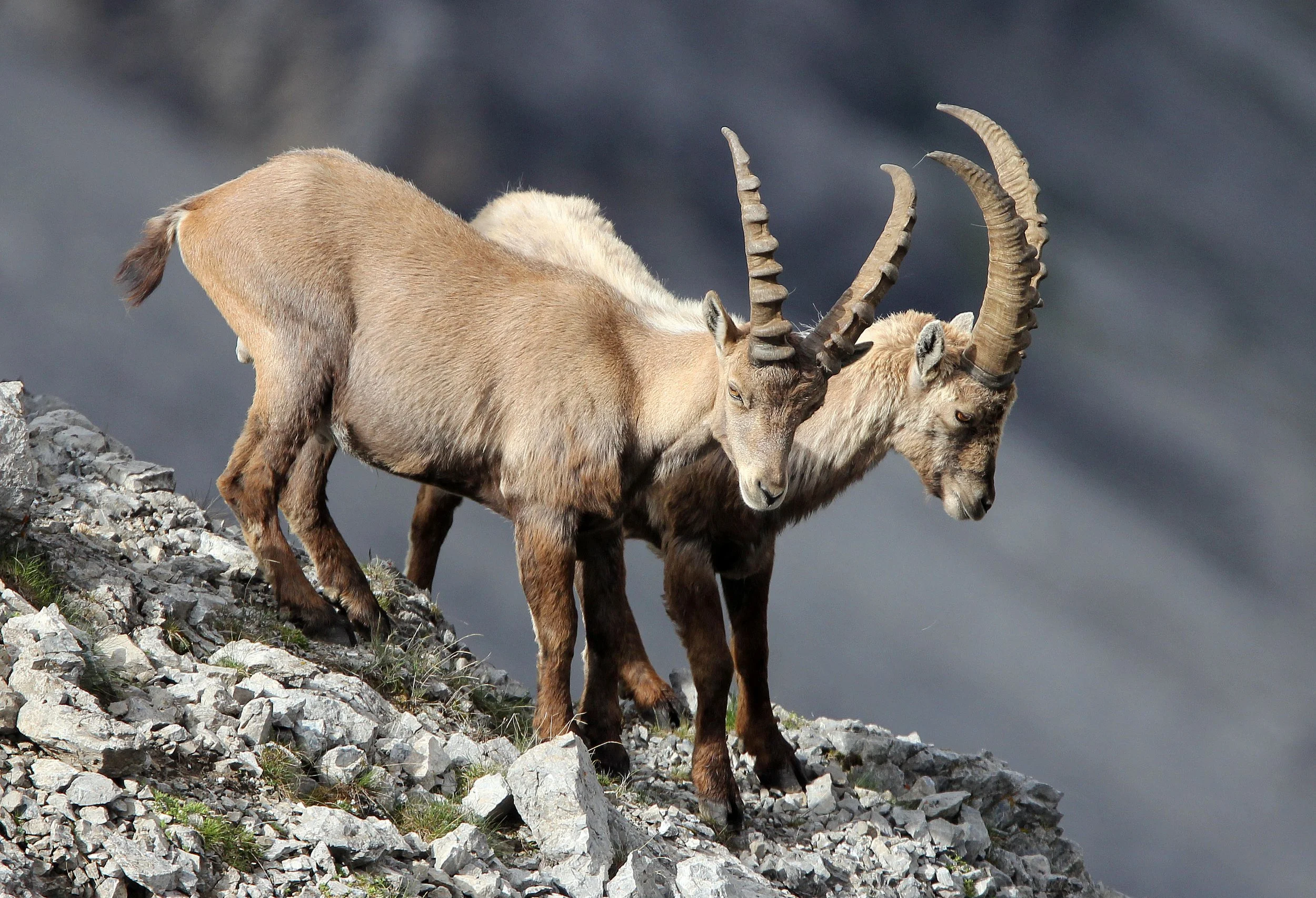

















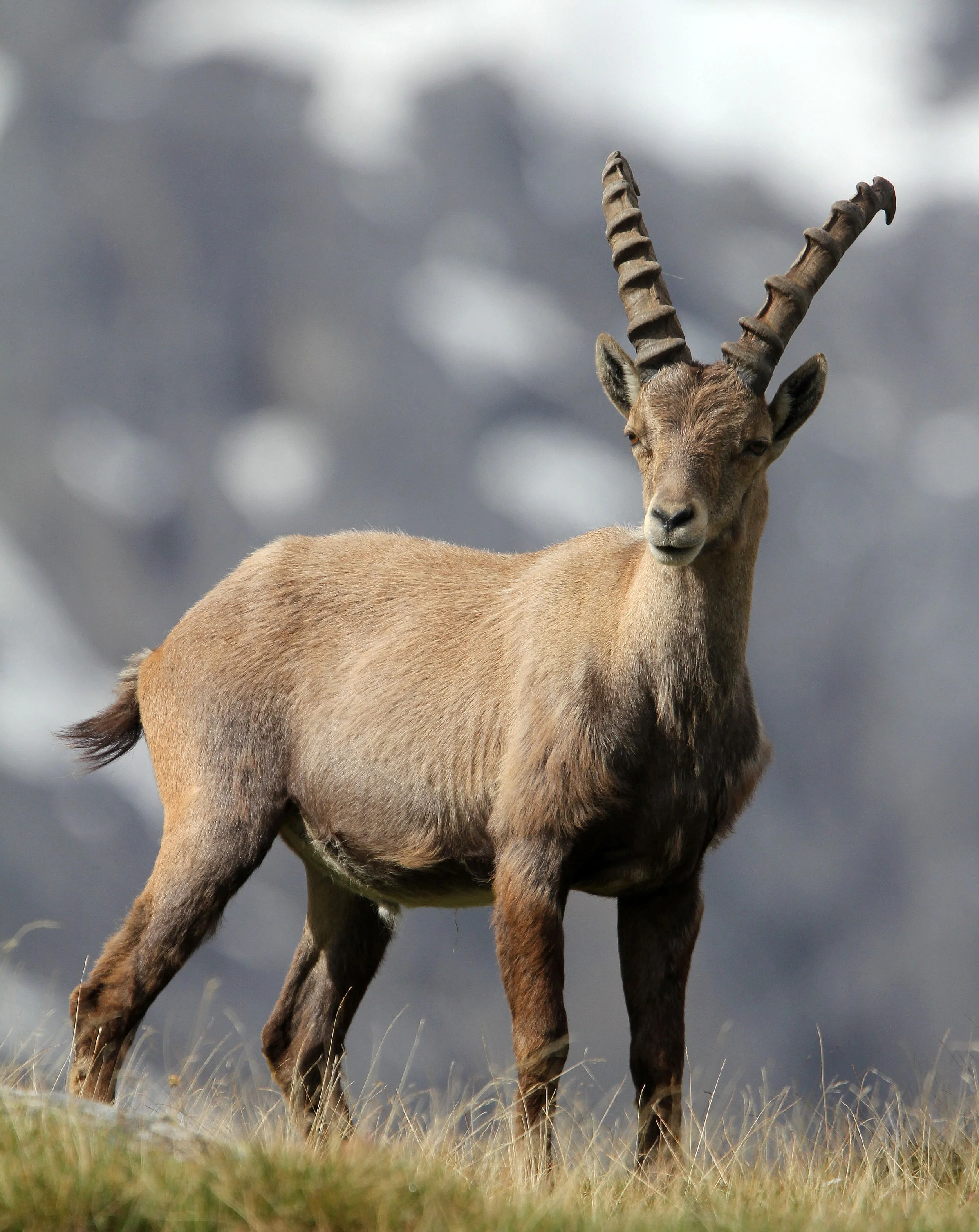








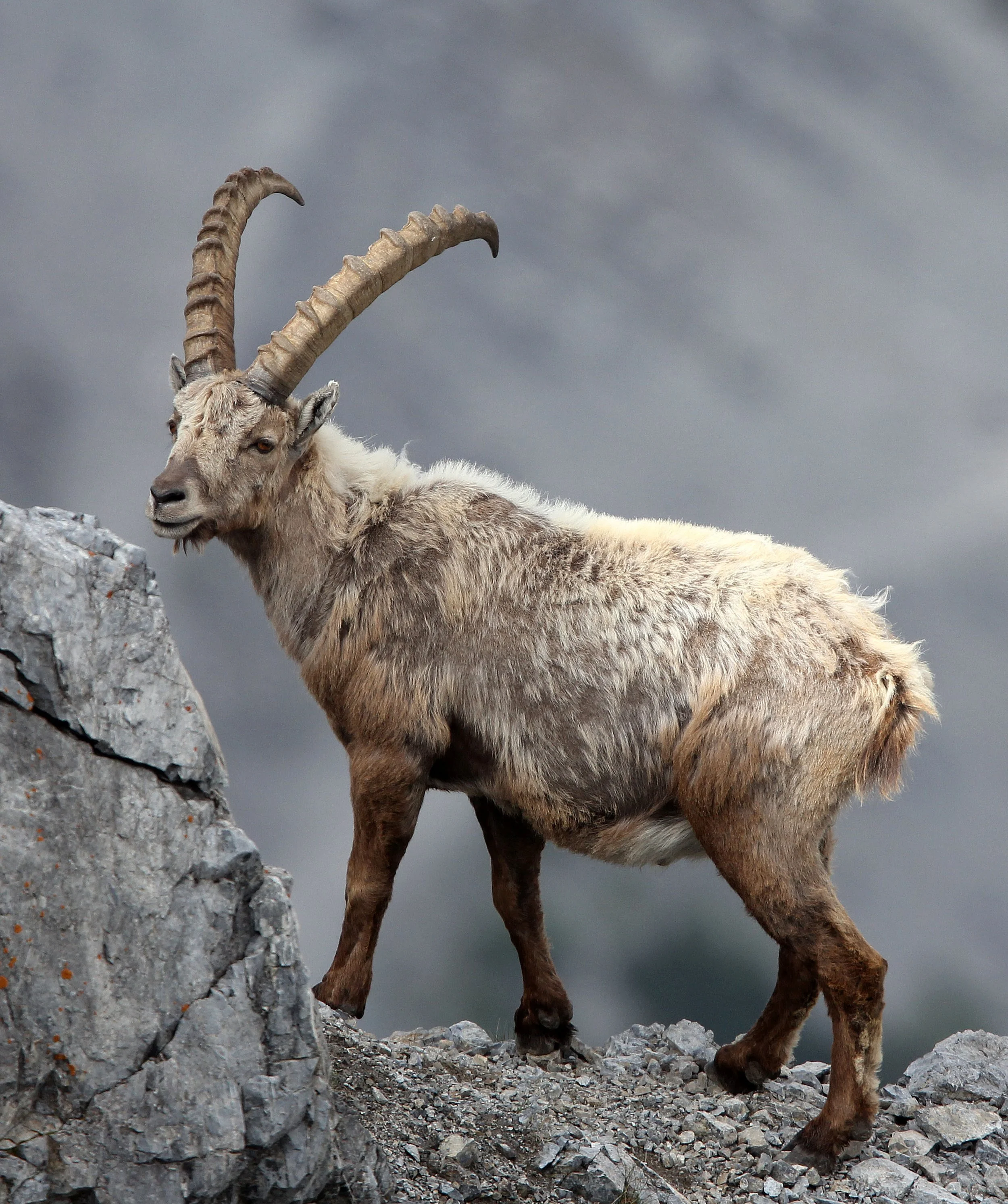













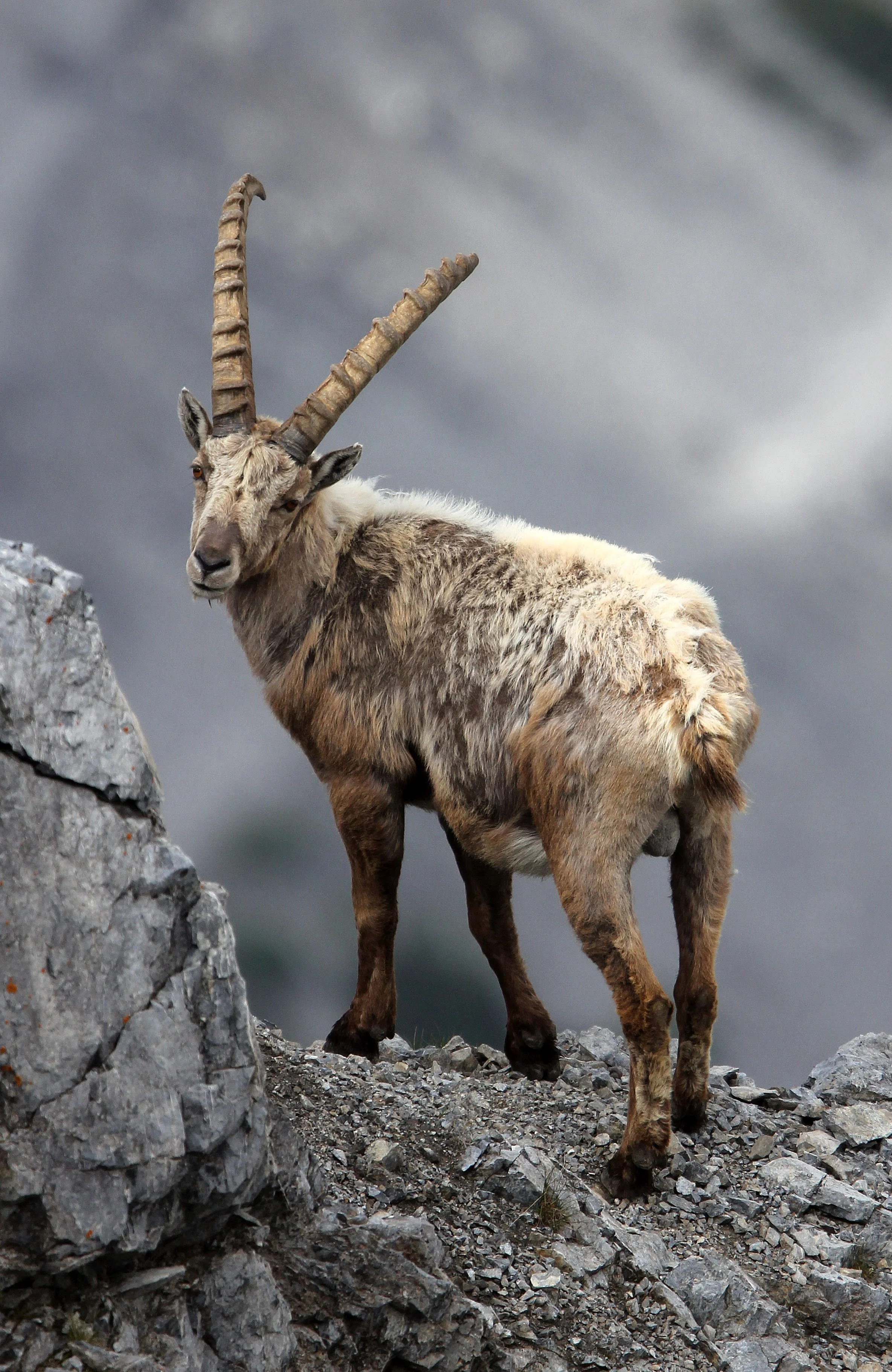












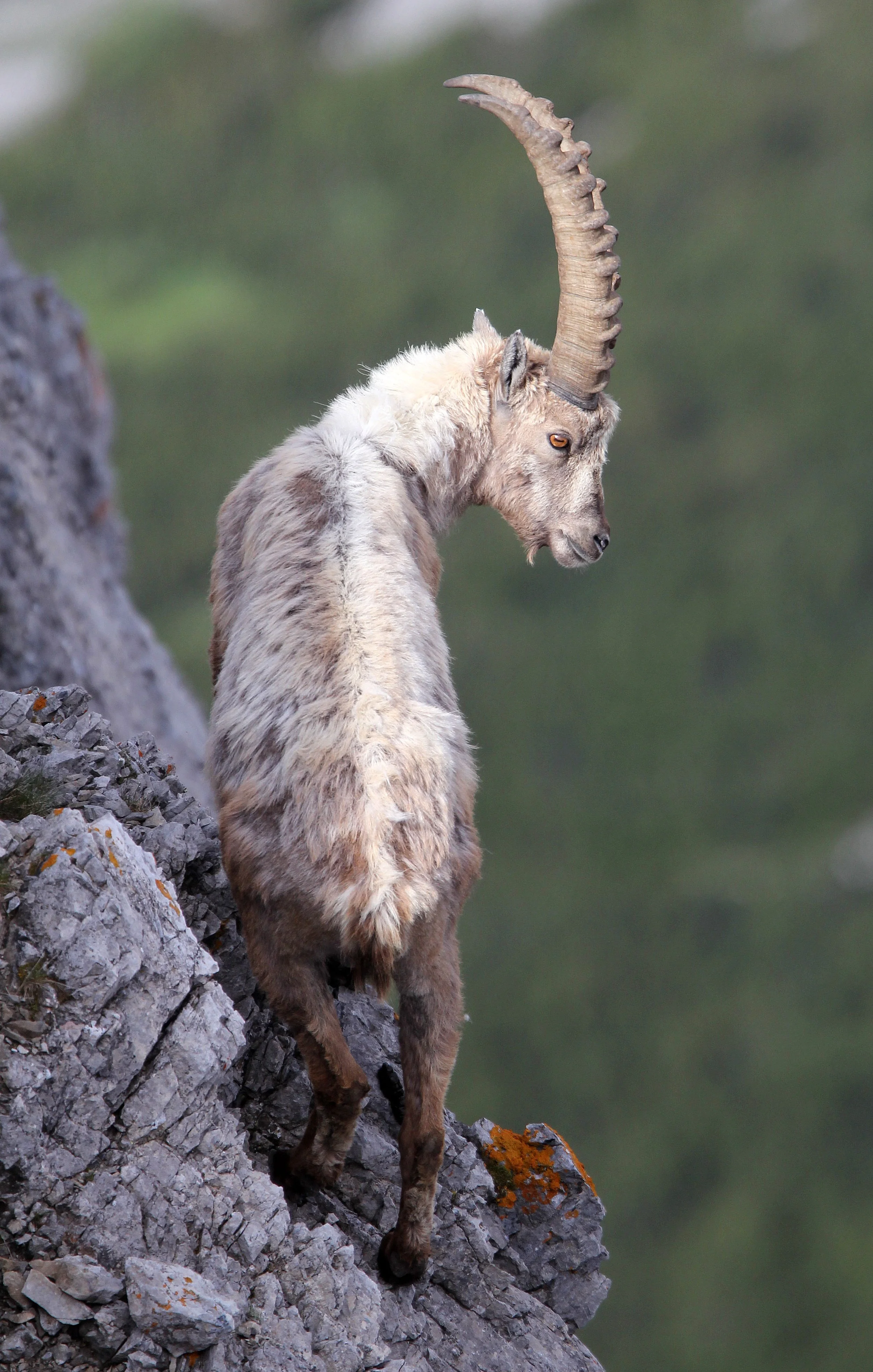






















































































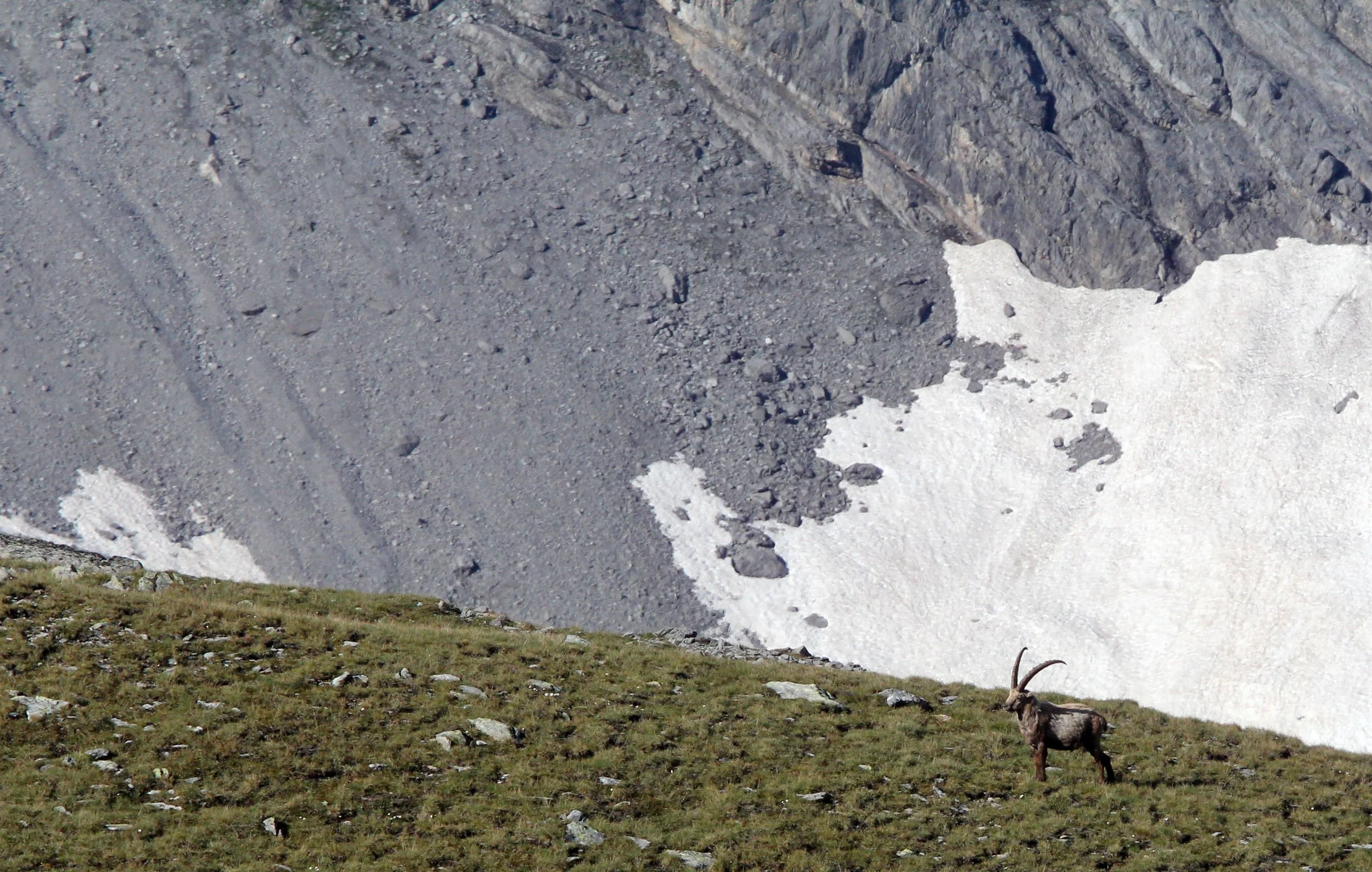
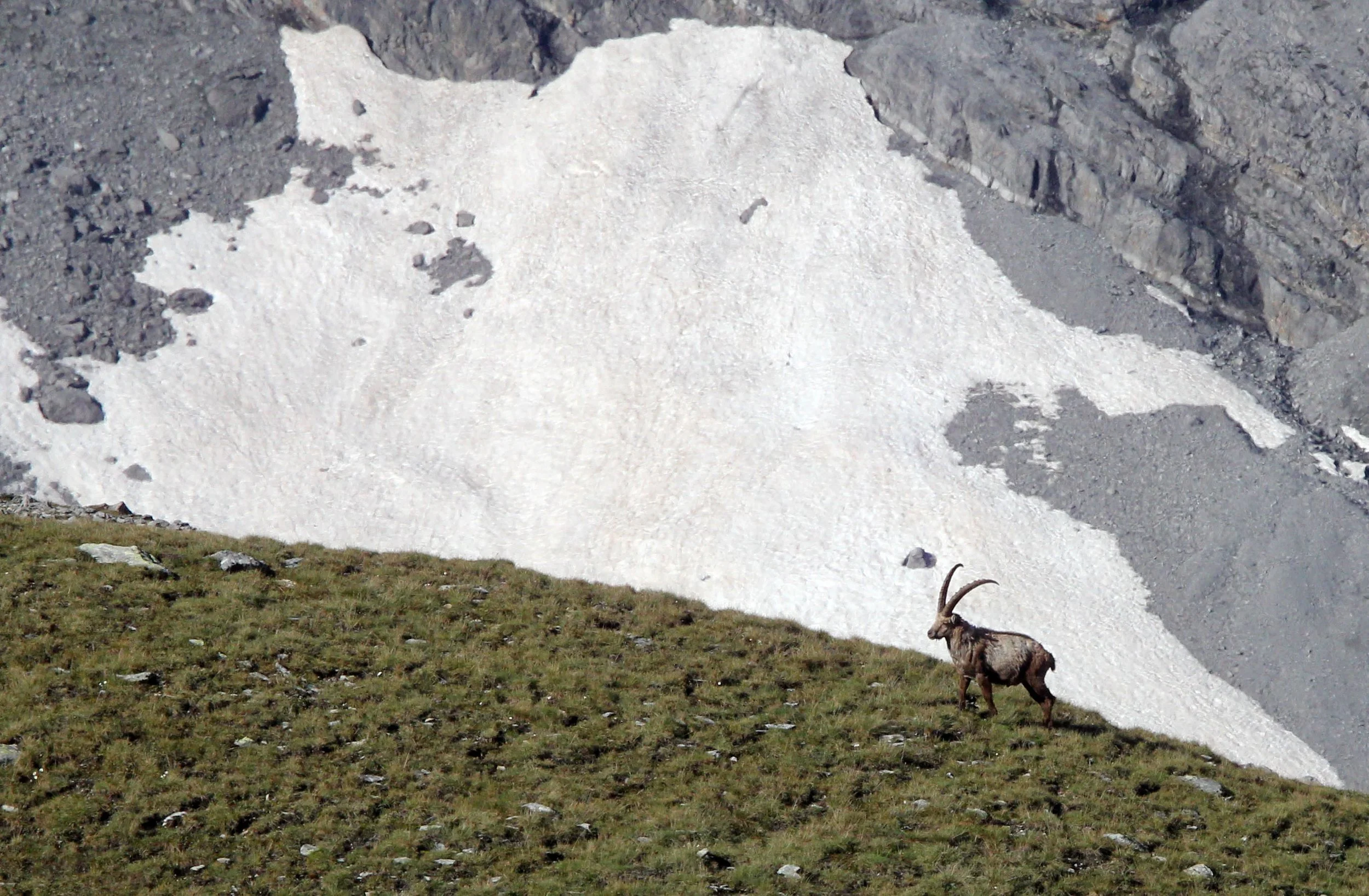















The Iberian ibex (Capra pyrenaica), also known as the Spanish ibex, Spanish wild goat, or Iberian wild goat, is a species of ibex endemic to the Iberian Peninsula. Four subspecies have been described; two are now extinct. The Portuguese subspecies became extinct in 1892, and the Pyrenean subspecies became extinct in 2000. A project to clone to the Pyrenean subspecies resulted in one clone being born alive in July 2003, making it the first taxon to become "un-extinct", although the clone died several minutes after birth due to physical defects in its lungs, therefore remaining extinct.
The Iberian ibex is characterized by its large and flexible hooves and short legs. These physical adaptations allow it to run and leap on bare, rocky, rough and steep slopes out of reach of potential predators. The horns of the Iberian ibex curve out and up and then back, inward, and, depending on subspecies, either up again or down. The annual horn growth is influenced principally by age but can also be contributed by environmental factors and the growth made in the previous year.[5] The Iberian ibex also shows sexual dimorphism, with the male being larger in size and weight and also having larger horns than the female. The bones of the female ibex ossify nearly two years before the bones of the male.
The Iberian ibex populates the Iberian Peninsula and consisted originally of four subspecies. However, with recent extinctions occurring within the last century, only two of the subspecies still exist. Both occur in Spain and along the coast in Portugal, as well a small reintroduced population in the French Pyrenees. It has been extirpated from Gibraltar and possibly Andorra.
The Western Spanish ibex or Gredos ibex (Capra pyrenaica victoriae) is a subspecies of Iberian ibex native to Spain, in the Sierra de Gredos. It was later introduced to other sites in Spain (Las Batuecas, La Pedriza, Riaño) and to northern Portugal (Peneda-Gerês National Park) as a replacement for the extinct Portuguese ibex (C. p. lusitanica).
Remnant populations survive in the Picos de Europa and other parts of the Cantabrian Mountains, along with some reintroductions. The largest population is in the mountains north of Riaño. It is also found in southern Galicia near the border with Portugal. In northern Portugal, 100 or so survive in the Peneda-Gerês National Park, which adjoins the larger population in southern Galicia. The Western Spanish ibex has been reintroduced to several areas for hunting purposes.[citation needed] Because of their limited distribution and narrow ecological niche, Western Spanish ibex are more at risk of extinction than their Southeastern Spanish ibex relatives. They are more vulnerable to climatic change and parasitic diseases might pose a threat to them. Therefore to further ensure their survival, the IUCN suggests distributing some of the Western Spanish ibex population to more areas.
The related Pyrenean ibex (Capra pyrenaica pyrenaica) which once ranged across the Pyrenees, went extinct in 2000. In 2014, a small number of Western Spanish ibex were introduced to France's Pyrenees National Park as a replacement for the Pyrenean ibex. By 2020, the population had increased to 400 individuals in the park, and neighboring Ariège.
Western Spanish or Gredos Ibex (Capra pyrenaica victoriae) - Sierra de Gredos National Park, Spain


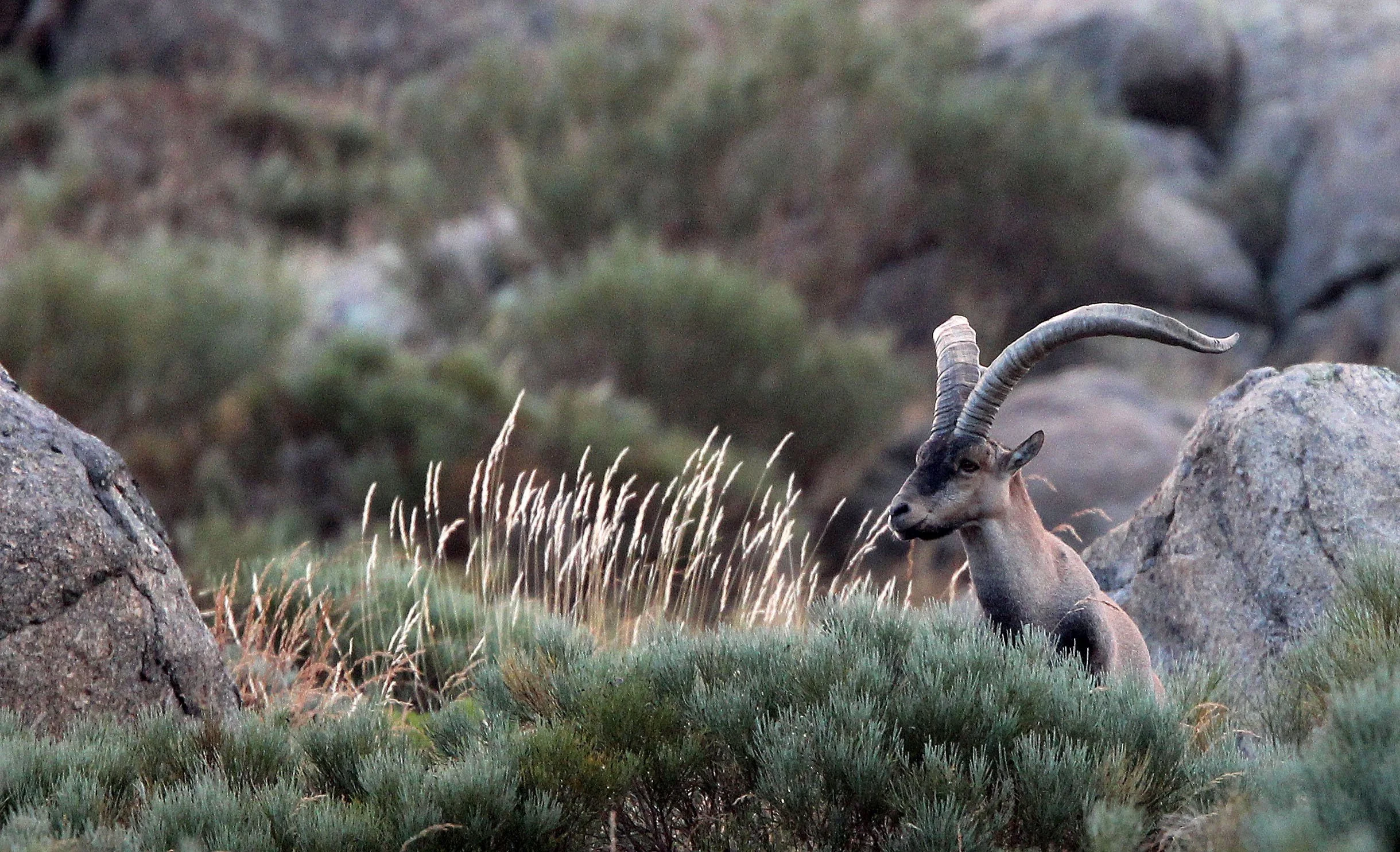










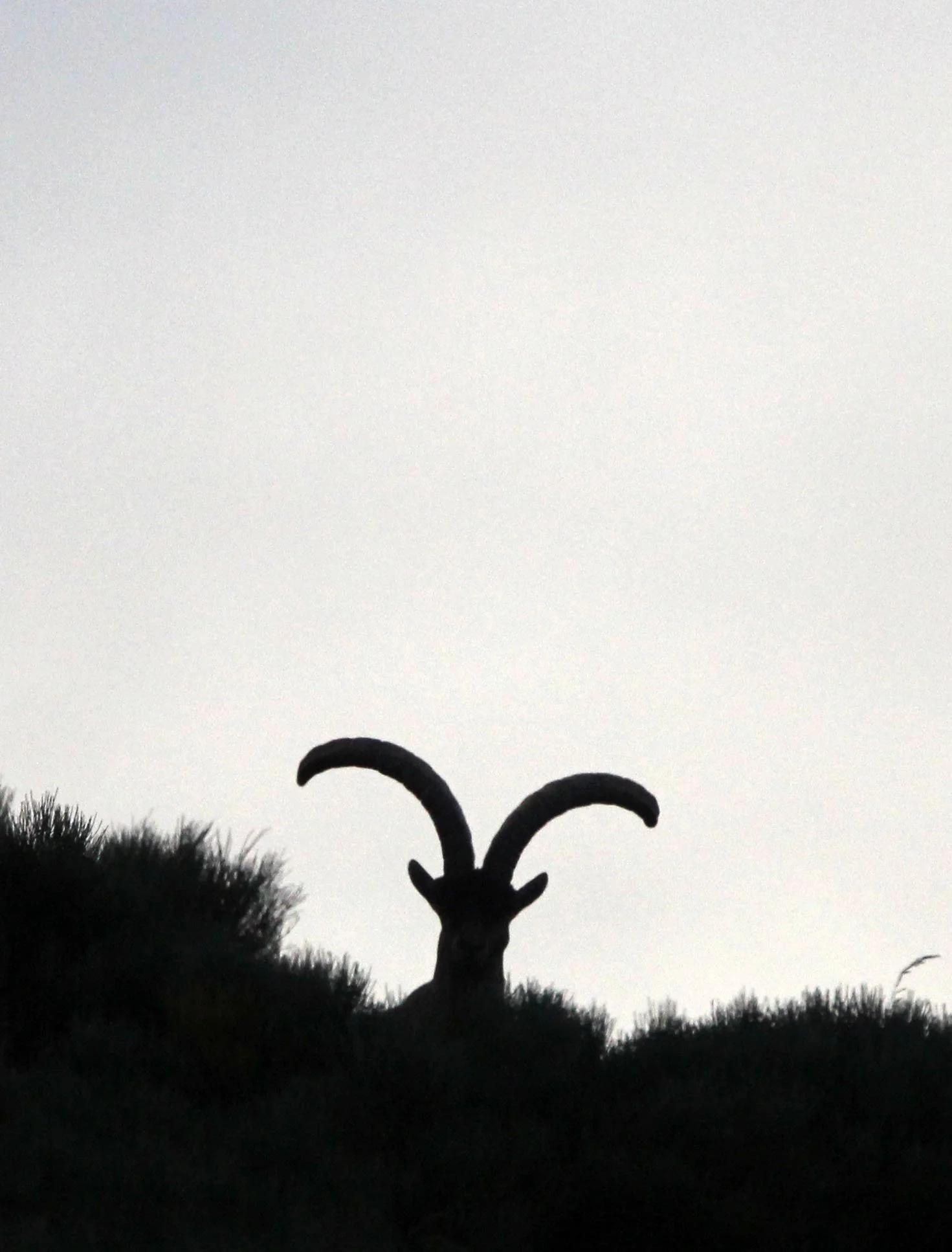














































































Southeastern or Sierra Nevada Ibex (Capra pyrenaica penibeticus) - Sierra Nevada National Park, Spain



















































































Southeastern or Beceite Ibex (Capra pyrenaica hispanica) - Sierra de Andujar National Park, Spain


















































Southeastern or Ronda Ibex (Capra pyrenaica meridionalis) - El Torcal National Park, Spain









































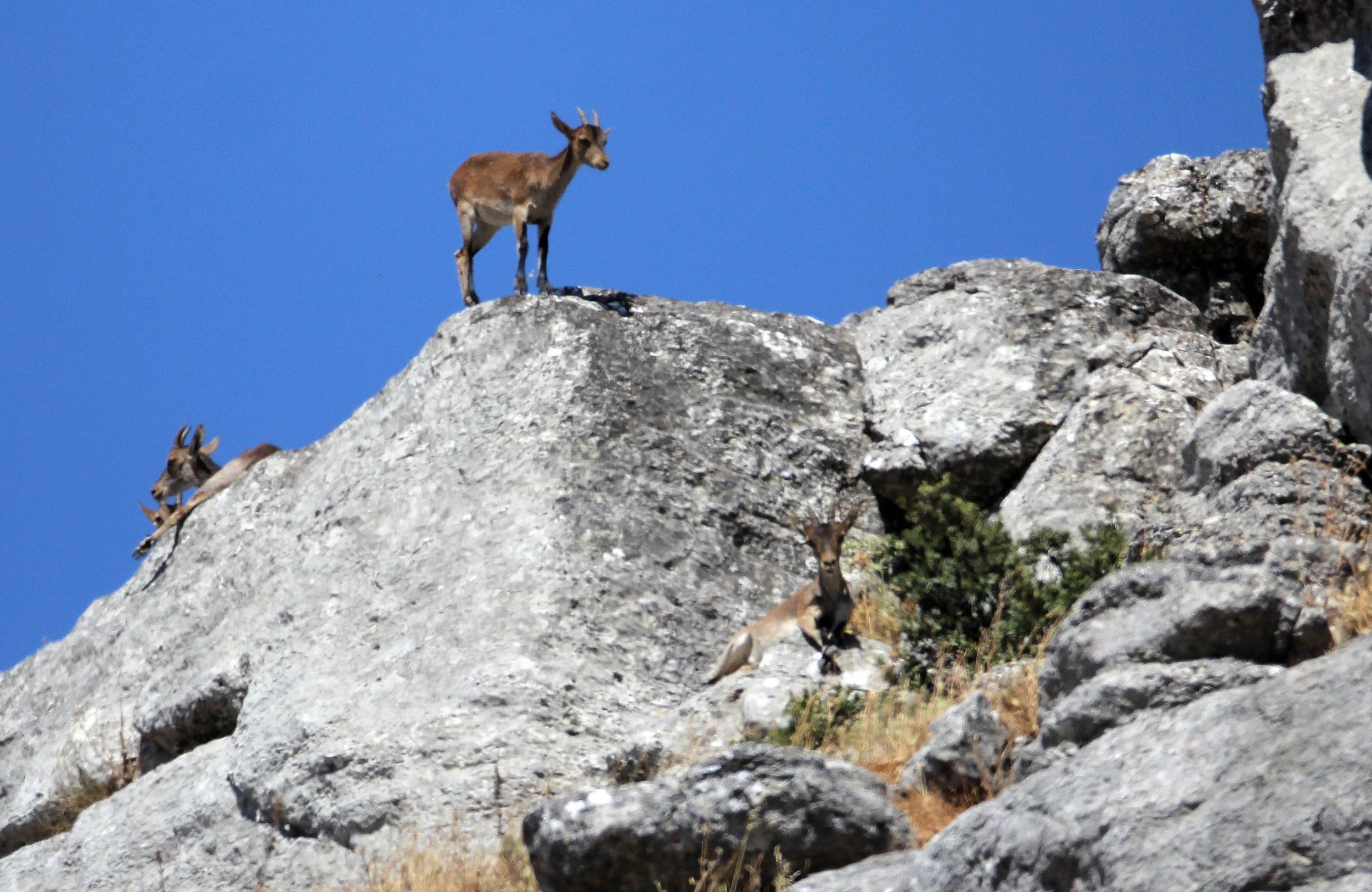





The Walia Ibex (Capra walie, Amharic: ዋልያ wālyā) is an endangered species of ibex. It is sometimes considered a subspecies of the Alpine ibex. Threats against the species include habitat loss, poaching, and restricted range; only about 500 individuals survived in the mountains of Ethiopia, concentrated in the Semien Mountains, largely due to past poaching and habitat depletion.[citation needed] If the population were to increase, the surrounding mountain habitat would be sufficient to sustain only 2,000 ibex. The adult walia ibex's only known wild predator is the hyena. However, young ibex are often hunted by a variety of fox and cat species. The ibex are members of the goat family, and the walia ibex is the southernmost of today's ibexes. In the late 1990s, the walia ibex went from endangered to critically endangered due to the declining population. The walia ibex is also known as the Abyssinian ibex. Given the small distribution range of the Walia ibex in its restricted mountain ecosystem, the presence of a large number of domestic goats may pose a serious threat that can directly affect the survival of the population.
These animals have a chocolate-brown to chestnut-brown coat coloration, greyish-brown muzzle, and a lighter grey in the eyes and legs. The belly and insides of the legs are white, and black and white patterns stretch upon the legs of these animals. The males weigh 80–125 kg (180-280 lb) and have very large horns which curve backwards, reaching lengths up to 110 cm (43 in). These horns are used for dominance disputes between males. The males also have distinguished black beards. The length of the walia ibex beard varies with age. The older males have longer, thicker beards than the young ones . Females also have horns, but they are shorter and thinner. Females are smaller and lighter in color. The horns on both males and females are rigid. The overall size of the walia ibex is smaller and slimmer than the alpine ibex.
Walia ibex live in herds ranging from five to 20 animals. However the older, more mature males are often more solitary, though they will remain within a short distance of the main herd most times and during the mating season and rejoin with the herd for breeding purposes. Breeding usually takes place during late fall and early winter. The following spring, the female will give birth to one or two offspring. A herd of walia ibex was noted to travel one half of a kilometer up to two kilometers per day.
The walia ibex lives in very steep, rocky cliff areas between 2,500 and 4,500 m (8,200 and 14,800 ft) high. Their habitats are mountain forests, subalpine grasslands, and scrub. They are grazers. Their diets include bushes, herbs, lichens, shrubs, grasses, and creepers. They are often seen standing on their hind legs to get to young shoots of giant heath. Walia ibex are most active in the morning and evening, and will rest in the sun on rock ledges. Males live in bachelor groups and females live in groups with their offspring. Mating season is at summit from March to May. Males compete for females by ramming their horns with amazing force. Gestation periods last 150–165 days. They reach sexual maturity at one year of age.
Walia Ibex (Capra walie) - Simien Mountains Ethiopia





































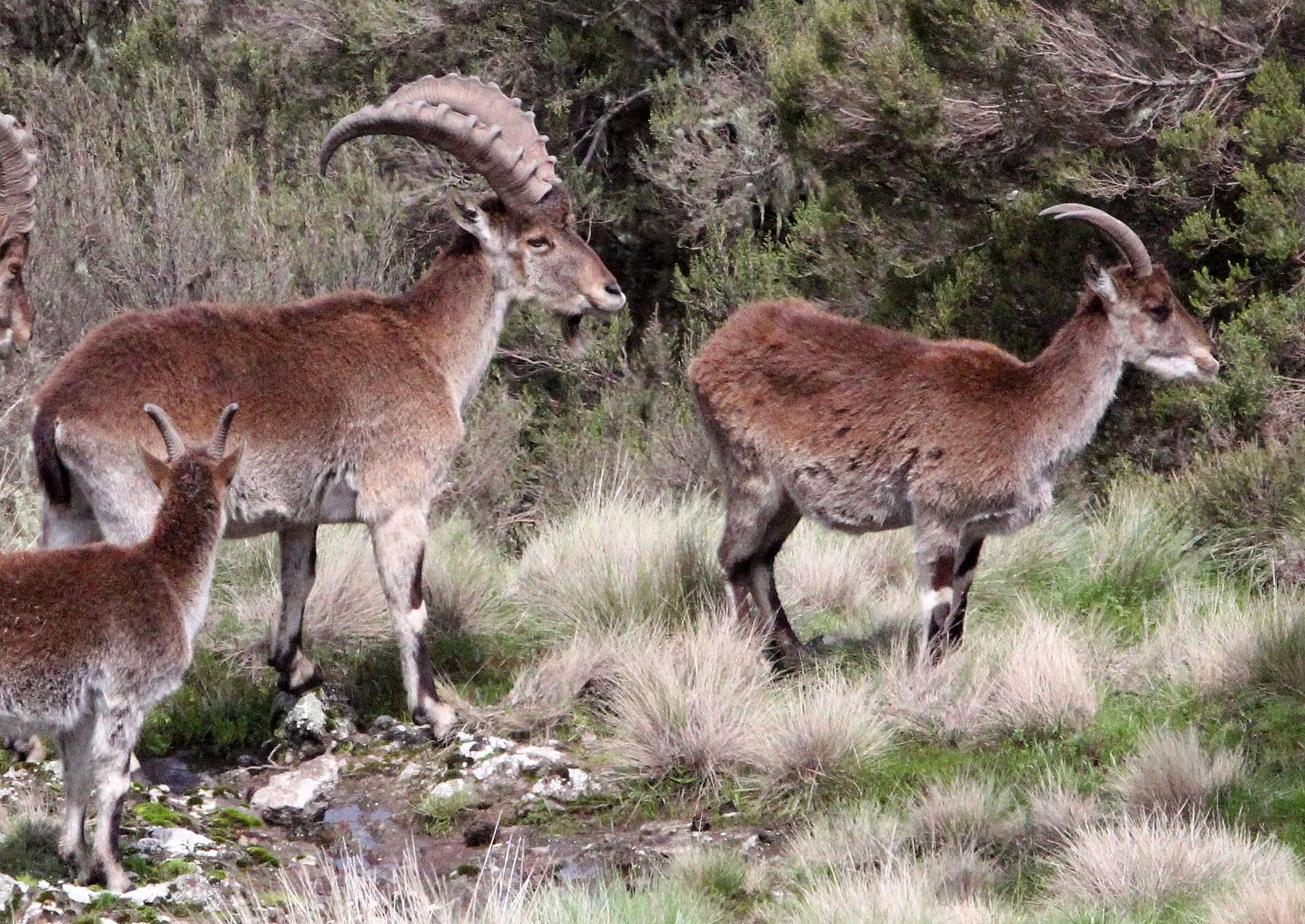























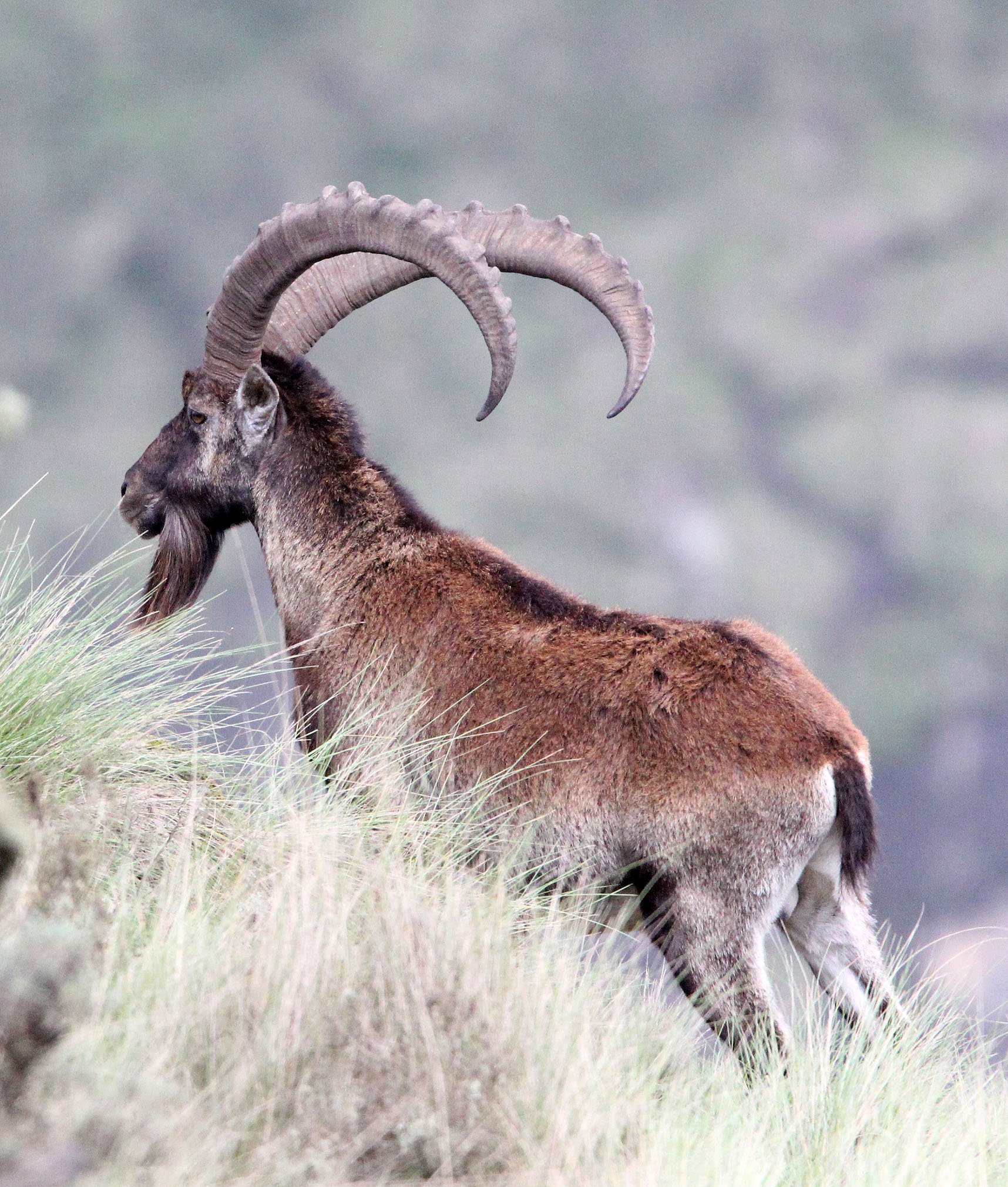






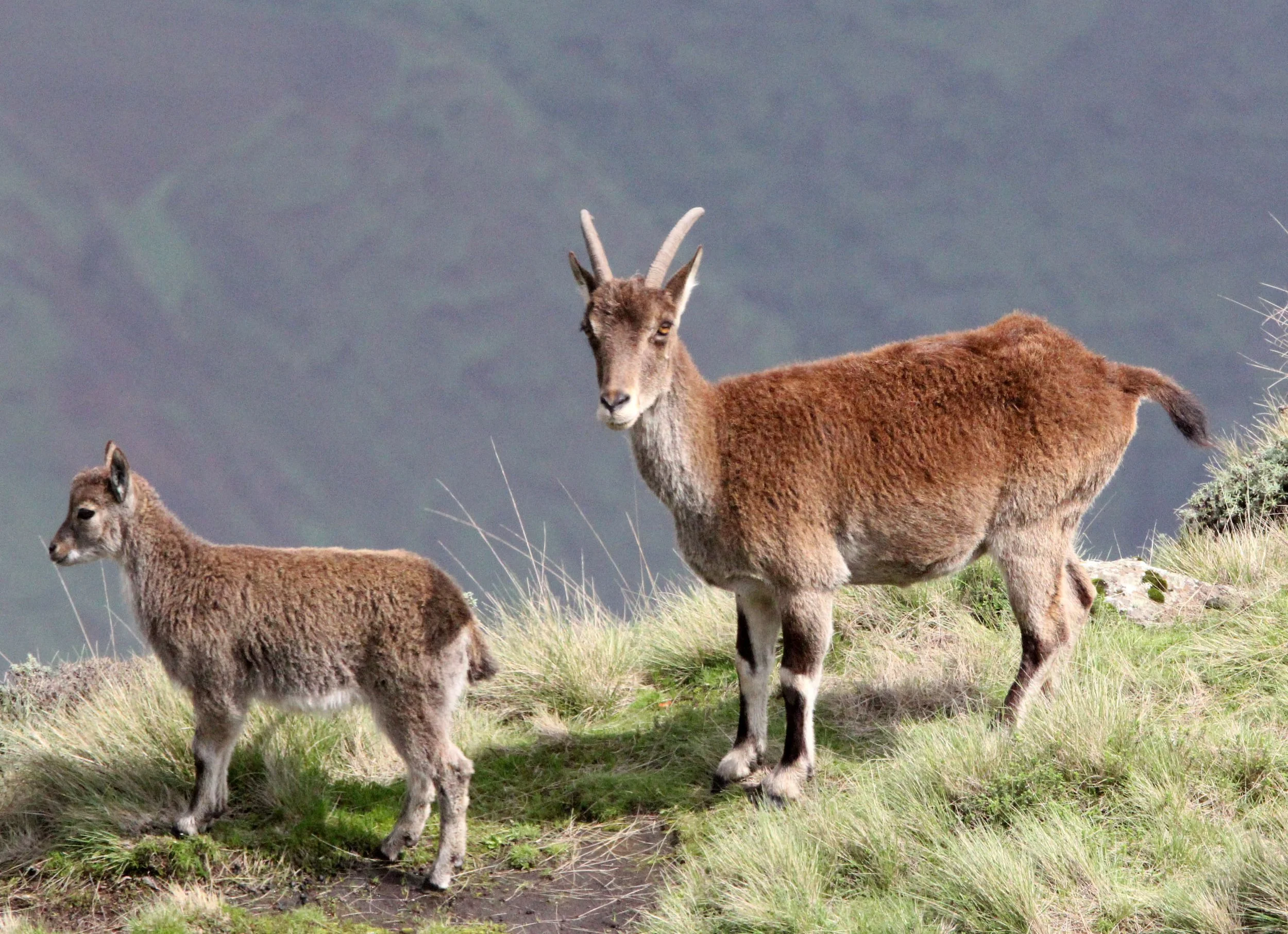



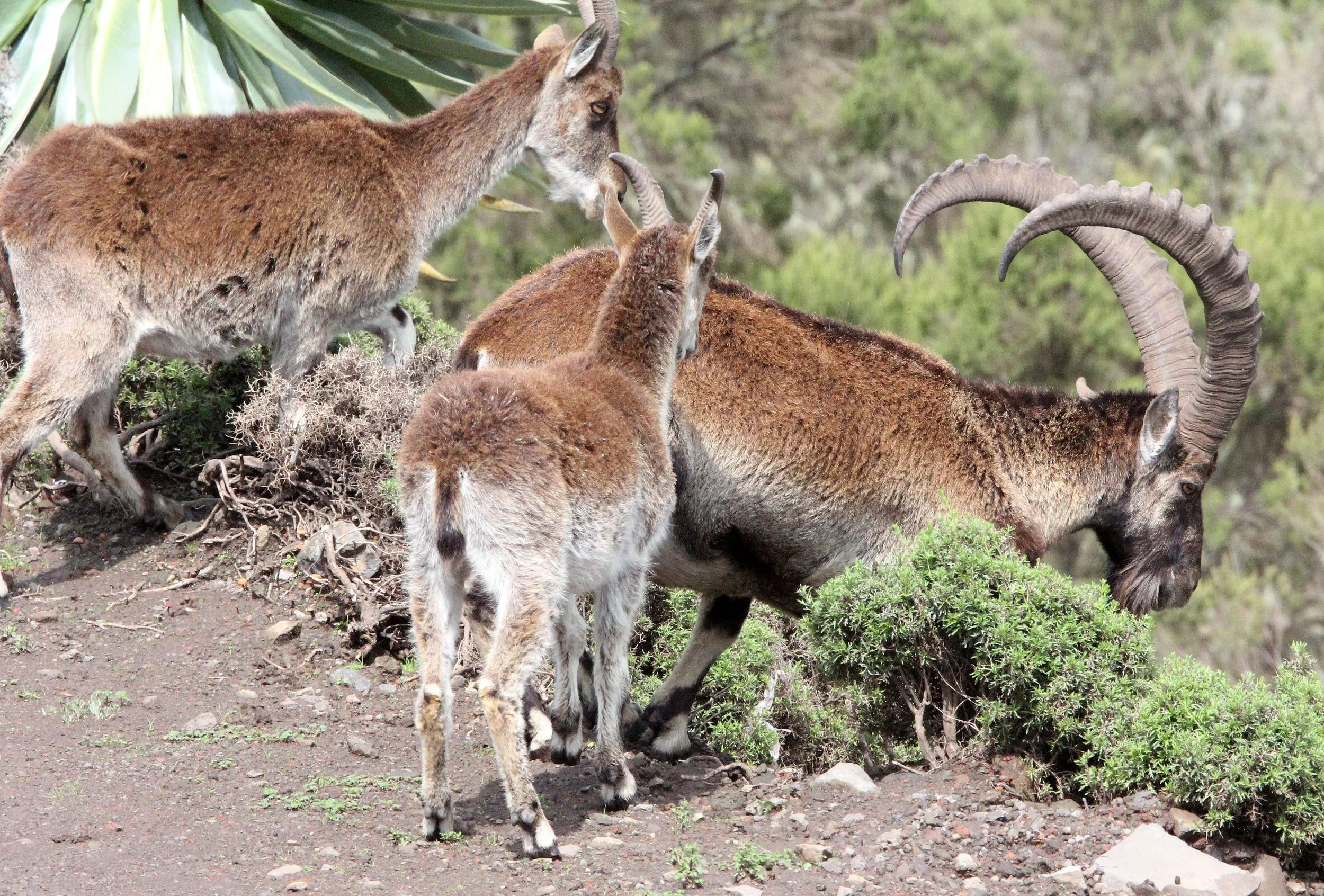
















































































Domestic Goats (Capra hircus)
























The kri-kri (Capra hircus cretica), sometimes called the Cretan goat, Agrimi, or Cretan Ibex, is a feral goat inhabiting the Eastern Mediterranean, previously considered a subspecies of wild goat. The kri-kri today is found only in Greece on three small islands just off the shore of Crete (Dia, Thodorou and Agii Pantes). The kri-kri can also be found on the island of Sapientza ( Messenian Oinousses ) which was brought to the island in great numbers, in order to protect the species from extinction.
The kri-kri has a light brownish coat with a darker band around its neck. It has two horns that sweep back from the head. In the wild they are shy and avoid humans, resting during the day. The animal can leap some distance or climb seemingly sheer cliffs.
The kri-kri is not thought to be indigenous to Crete, most likely having been imported to the island during the time of the Minoan civilization.It was once common throughout the Aegean but the peaks of the 2,400 m (8,000 ft) White Mountains of Western Crete are their last strongholds—particularly a series of almost vertical 900 m (3,000 ft) cliffs called 'the Untrodden'—at the head of the Samaria Gorge. This mountain range, which hosts another 14 endemic animal species, is protected as a UNESCO Biosphere Reserve. In total, their range extends to the White Mountains, the Samaria National Forest and the islets of Dia, Thodorou, and Agii Pandes. Recently some were introduced onto two more islands.
By 1960, the kri-kri was under threat, with a population below 200. It had been the only meat available to mountain guerillas during the German occupation in World War II. Its status was one reasons why the Samaria Gorge became a national park in 1962. There are still only about 2,000 animals on the island and they are considered vulnerable: hunters still seek them for their tender meat, grazing grounds have become scarcer and disease has affected them. Hybridization is also a threat, as the population has interbred with ordinary goats. Hunting them is strictly prohibited.
Archaeological excavations have unearthed several depictions of the kri-kri. Some academics believe that the animal was worshiped during antiquity. On the island, males are often called 'agrimi' (Greek: αγρίμι, i.e. 'the wild one'), while the name 'sanada' (Greek: σανάδα) is used for the female. The kri-kri is a symbol of the island, much used in tourism marketing and official literature.
As molecular analyses demonstrate, the kri-kri is not, as previously thought, a distinct subspecies of wild goat. Rather, it is a feral domestic goat, derived from the first stocks of goats domesticated in the Levant and other parts of the Eastern Mediterranean around 8000-7500 BCE. Therefore, it represents a nearly ten-thousand-year-old "snapshot" of the first domestication of goats.
Kri Kri Wild Goats (Capra hircus cretica) - Crete Island. Captive male named “Rambo” - a movie star!






























































































































